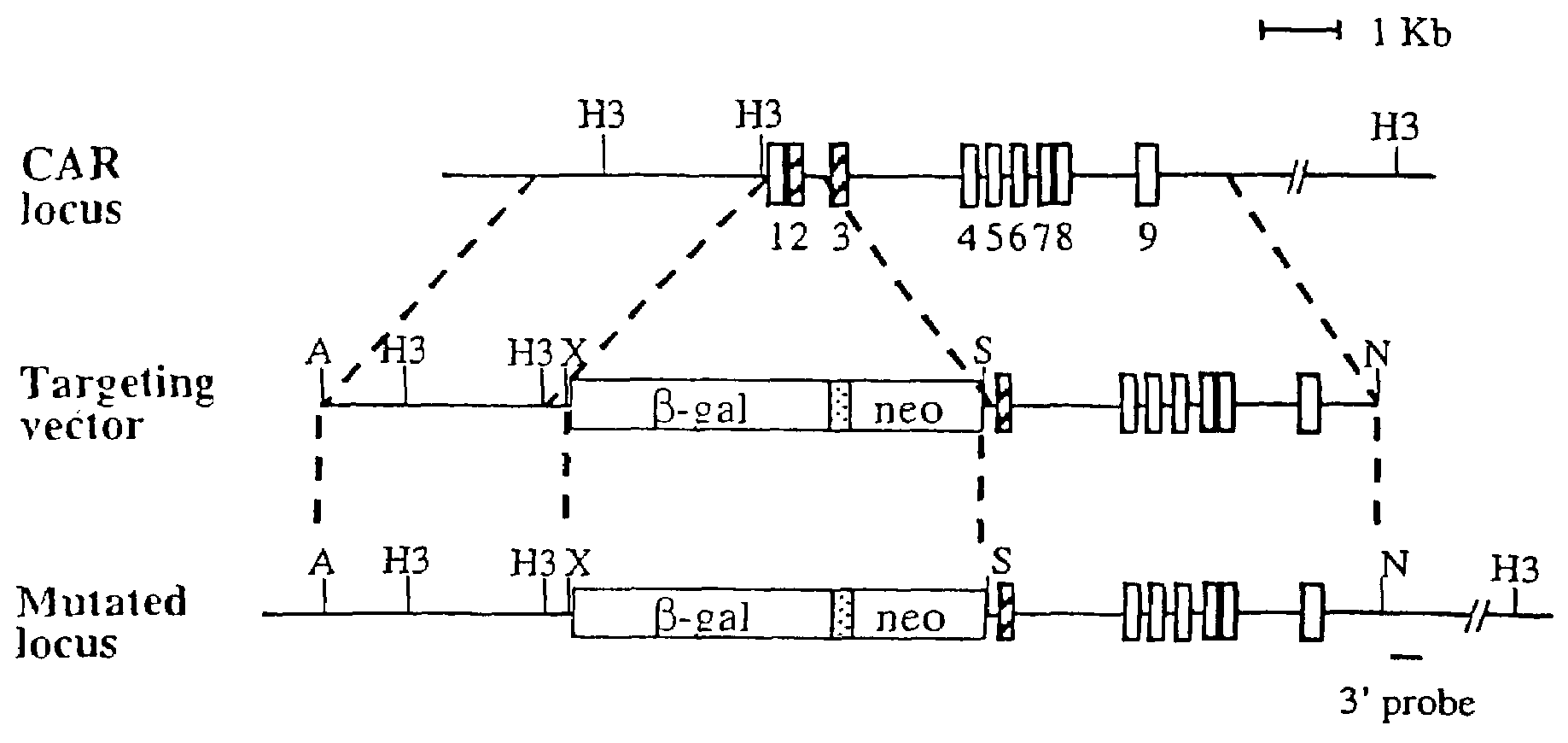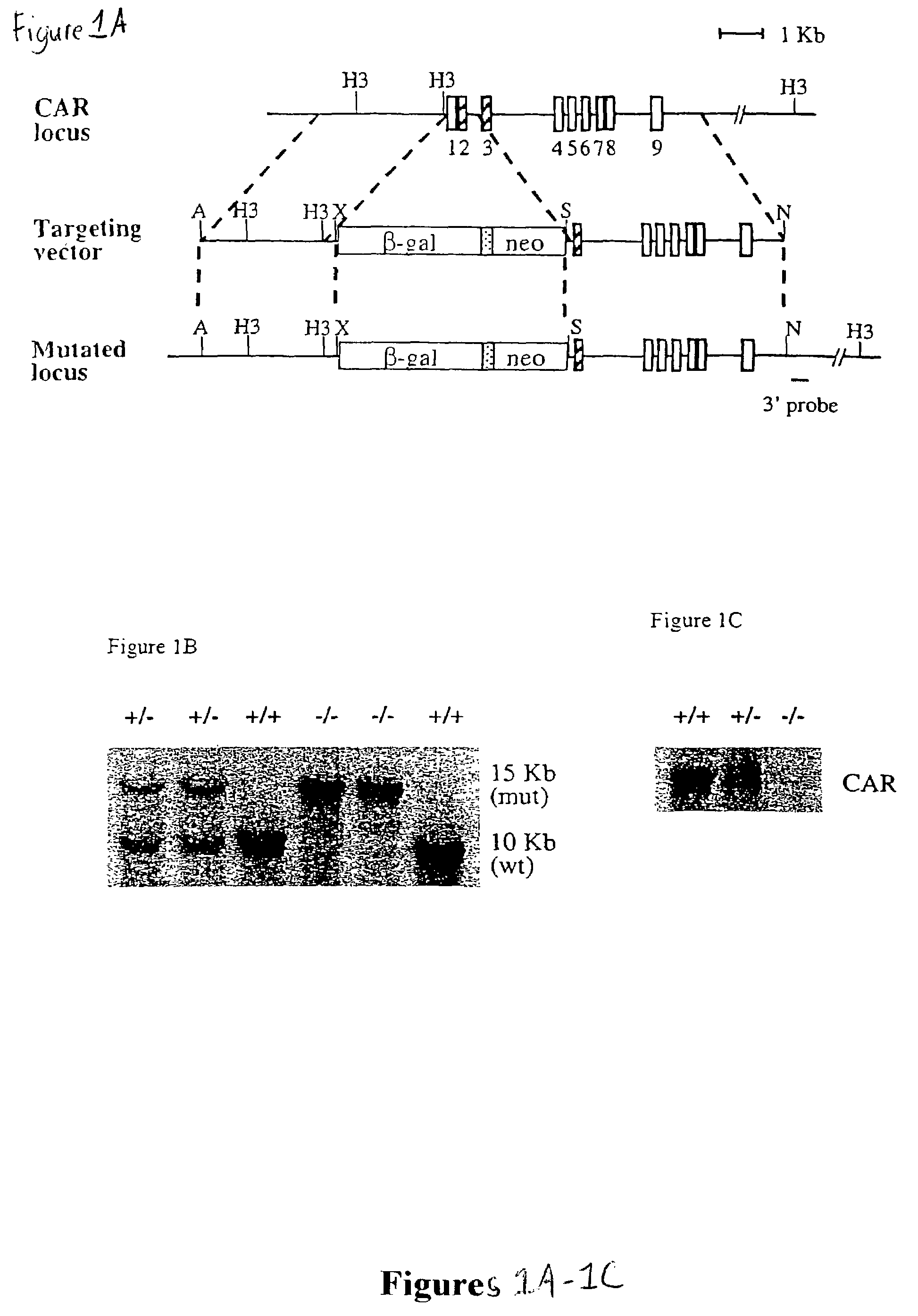Screening systems and methods for identifying modulators of xenobiotic metabolism
a technology of xenobiotic metabolism and screening systems, applied in biochemistry apparatus and processes, instruments, animal/human proteins, etc., can solve problems such as potentially toxic activating compounds, and achieve the effects of reducing side effects, facilitating compound identification, and reducing car-mediated metabolism of therapeutically active compounds
- Summary
- Abstract
- Description
- Claims
- Application Information
AI Technical Summary
Benefits of technology
Problems solved by technology
Method used
Image
Examples
example 1
Targeting Vector Construction
[0130]To construct the targeting vector for the CAR locus, an XbaI-EagI fragment containing the nuclear localized β-galactosidase gene from vector pPD 46.21 was subcloned into the XbaI and EcoRI sites of the pGKneo plasmid. DNA from AB 1 ES cells was used to amplify CAR genomic fragments for both 5′ and 3′ arms. For the 5′ arm, a 3 kb CAR promoter fragment was cloned into the ApaI and XbaI sites. For the 3′ arm, a 5 kb fragment spanning exons 3 to 9 was cloned into the SalI and NotI sites. The primers for the 5′ arm were 5′-gcgcgcgggccctggcatacattaacacaaacacatacatat-3′ (SEQ ID NO.: 3) and 5′-gcgcgctctagaaggacccagactctggacccagggcaaaga-3′ (SEQ ID NO: 4). The primers for the 3′ arm were 5′-gcgcgcgtcgacaggtgaagtgcttctccccaacagaaacaa-3′ (SEQ ID NO: 5) and 5′-gcgcgcgcggccgctgtcctgggagcagcctctgcagccgct-3′ (SEQ ID NO: 6).
example 2
Generation of CAR Receptor Knockout Mice
[0131]ABI ES cells (107) were electroporated with 25 μg targeting construct in 0.9 ml PBS using a Bio-Rad Gene Pulser (500 μF, 230 V). The cells were then plated on one or two 10-cm plates containing a monolayer of irradiated STO feeder cells. About twenty-four hours later, the cells were subjected to G418 selection (350 μg / ml, Gibco) for 9 days. Resistant clones were analyzed by Southern blotting after HindIII digestion, using the 3′ probe indicated in FIG. 1A (FIG. 1B). The primers for the 3′ probe were 5′-ggacaacctcagcccacagtgatgc-3′ (SEQ ID NO: 7) and 5′-tcctttggttaccacctgactctgc-3′ (SEQ ID NO: 8). Two positive clones were expanded and injected into C57BL / 6 blastocysts. Male chimeras were back crossed to C57BL / 6 female mice. Heterozygotes were determined by Southern blotting and intercrossed to generate homozygotes.
example 3
Analysis of CAR and CAR Knockout Mice
[0132]To assess the functional role of CAR, two independent mouse lines were generated in which a promoter proximal segment of the CAR gene, including a portion of the DNA binding domain, was replaced by the coding region for β-galactosidase (FIG. 1A). These β-galactosidase “knockin” animals were unable to express CAR mRNA (FIG. 1C). This loss of CAR expression did not result in any overt phenotype; homozygous CAR − / − animals were born at expected Mendelian frequency, and both male and female CAR − / − animals were fertile.
PUM
| Property | Measurement | Unit |
|---|---|---|
| Fraction | aaaaa | aaaaa |
| Time | aaaaa | aaaaa |
| Time | aaaaa | aaaaa |
Abstract
Description
Claims
Application Information
 Login to View More
Login to View More - R&D
- Intellectual Property
- Life Sciences
- Materials
- Tech Scout
- Unparalleled Data Quality
- Higher Quality Content
- 60% Fewer Hallucinations
Browse by: Latest US Patents, China's latest patents, Technical Efficacy Thesaurus, Application Domain, Technology Topic, Popular Technical Reports.
© 2025 PatSnap. All rights reserved.Legal|Privacy policy|Modern Slavery Act Transparency Statement|Sitemap|About US| Contact US: help@patsnap.com



